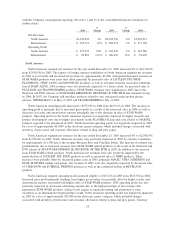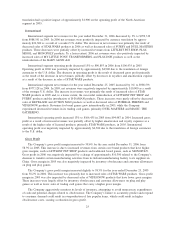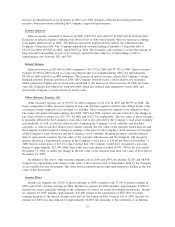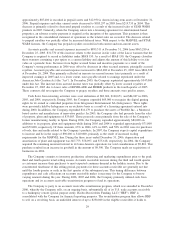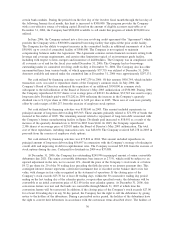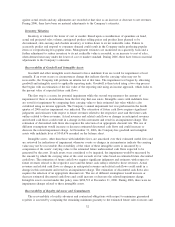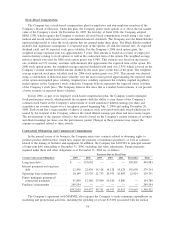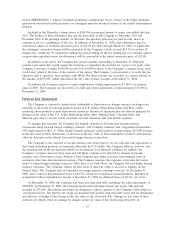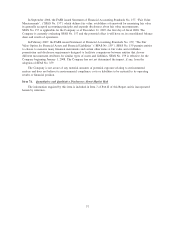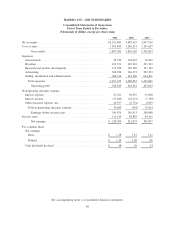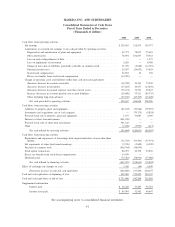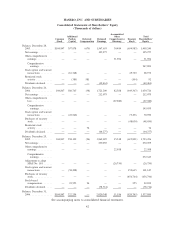Hasbro 2006 Annual Report Download - page 43
Download and view the complete annual report
Please find page 43 of the 2006 Hasbro annual report below. You can navigate through the pages in the report by either clicking on the pages listed below, or by using the keyword search tool below to find specific information within the annual report.
against actual results and any adjustments are recorded at that time as an increase or decrease to net revenues.
During 2006, there have been no material adjustments to the Company’s estimates.
Inventory Valuation
Inventory is valued at the lower of cost or market. Based upon a consideration of quantities on hand,
actual and projected sales volume, anticipated product selling prices and product lines planned to be
discontinued, slow-moving and obsolete inventory is written down to its net realizable value. Failure to
accurately predict and respond to consumer demand could result in the Company under producing popular
items or overproducing less popular items. Management estimates are monitored on a quarterly basis and a
further adjustment to reduce inventory to its net realizable value is recorded, as an increase to cost of sales,
when deemed necessary under the lower of cost or market standard. During 2006, there have been no material
adjustments to the Company’s estimates.
Recoverability of Goodwill and Intangible Assets
Goodwill and other intangible assets deemed to have indefinite lives are tested for impairment at least
annually. If an event occurs or circumstances change that indicate that the carrying value may not be
recoverable, the Company will perform an interim test at that time. The impairment test begins by allocating
goodwill and intangible assets to applicable reporting units. Goodwill is then tested using a two step process
that begins with an estimation of the fair value of the reporting unit using an income approach, which looks to
the present value of expected future cash flows.
The first step is a screen for potential impairment while the second step measures the amount of
impairment if there is an indication from the first step that one exists. Intangible assets with indefinite lives
are tested for impairment by comparing their carrying value to their estimated fair value which is also
calculated using an income approach. The Company’s annual impairment test was performed in the fourth
quarter of 2006 and no impairment was indicated. The estimation of future cash flows requires significant
judgments and estimates with respect to future revenues related to the respective asset and the future cash
outlays related to those revenues. Actual revenues and related cash flows or changes in anticipated revenues
and related cash flows could result in a change in this assessment and result in an impairment charge. The
estimation of discounted cash flows also requires the selection of an appropriate discount rate. The use of
different assumptions would increase or decrease estimated discounted cash flows and could increase or
decrease the related impairment charge. At December 31, 2006, the Company has goodwill and intangible
assets with indefinite lives of $545,676 recorded on the balance sheet.
Intangible assets, other than those with indefinite lives, are amortized over their estimated useful lives and
are reviewed for indications of impairment whenever events or changes in circumstances indicate the carrying
value may not be recoverable. Recoverability of the value of these intangible assets is measured by a
comparison of the assets’ carrying value to the estimated future undiscounted cash flows expected to be
generated by the asset. If such assets were considered to be impaired, the impairment would be measured by
the amount by which the carrying value of the asset exceeds its fair value based on estimated future discounted
cash flows. The estimation of future cash flows requires significant judgments and estimates with respect to
future revenues related to the respective asset and the future cash outlays related to those revenues. Actual
revenues and related cash flows or changes in anticipated revenues and related cash flows could result in a
change in this assessment and result in an impairment charge. The estimation of discounted cash flows also
requires the selection of an appropriate discount rate. The use of different assumptions would increase or
decrease estimated discounted cash flows and could increase or decrease the related impairment charge.
Intangible assets covered under this policy were $456,519 at December 31, 2006. During 2006, there were no
impairment charges related to these intangible assets.
Recoverability of Royalty Advances and Commitments
The recoverability of royalty advances and contractual obligations with respect to minimum guaranteed
royalties is assessed by comparing the remaining minimum guaranty to the estimated future sales forecasts and
32




